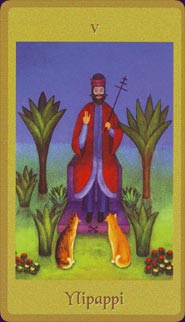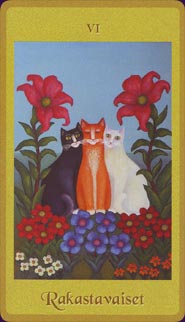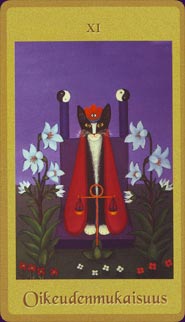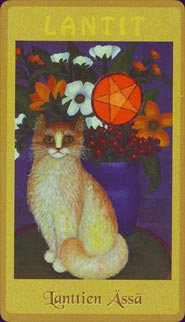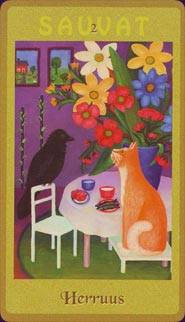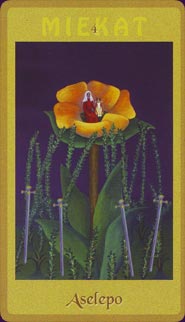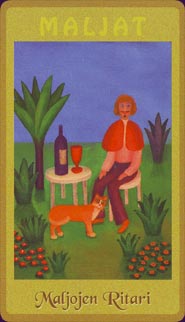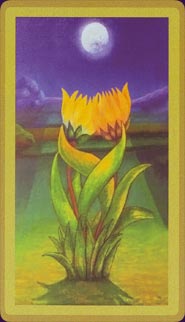Kissatarot Deck Review
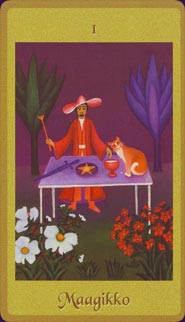
Creators: Terttu Seule
Publisher: Unio Mystica 2009
The Kissatarot is a Finnish tarot deck, which translates as the 'CatTarot'. It's a calm feeling deck illustrated in a colourful, 'naive' style, where inscrutable cats sometimes replace the human figures on the cards, and are sometimes in addition to them.
Retailers
See Price at KissatarotKissatarot Review by Nisaba Merrieweather
I am one of the lucky ones: a user of Tarot living outside of Finland who has managed to get their hands on a copy of this appealing deck. I first became aware of it during discussions on the Aeclectic Tarot forums, and was immediately intrigued by the look of the cards online.
In the flesh they are even more appealing. Presented in a two-piece box, really sturdy and with a larger-than-lifesize copy of "strength" on the front, the cards are well-protected by a box that is so appealing in its shades of purple and yellow that if I were to give this deck away, gift-wrapping would only worsten the effect.
The backs of the cards are really classy: two stylised yellow flowers twined, lover-like around each other, under a gibbous moon in the deck's trademark purple sky. The back itself feels like a full Tarot image, and has a sense of silence, awe and holiness: until I saw the image on the Moon card, I assumed it was an extract or a replica of the Moon used for the backs.
There is no LWB or companion volume for this deck. This could be a problem for a beginner, but for someone already involved in Tarot it is really a non-issue. LWBs tend to be reasonably unhelpful, anyway. The cardstock is laminated with a mid-satin finish, and not too laminated - it does not have that unlikeable plasticy or glassy feel to it that some other laminated decks have. I have not owned and shuffled my deck enough to be able to tell much about the cardstock yet, about whether it is reasonably resilient or whether it will start curling or suffer in other ways with use.
With fully-illustrated pips, this deck nevertheless seems to follow the Thoth blueprint at least as far as the Court Cards are concerned, with queens and princesses taking precedent over princes and knights. The imagery of the Majors and the Pips don't really remind me of any given Tarot tradition, though: there are some echoes of Thothian imagery in some cards, some distant echoes of RWS imagery in others, and yet others seem to have their own symbolism. That being said, the deck meshes together well - it does not feel disparate and so far it seems to work very well and read very clearly.
As the deck originated in Finland I was expecting come cold, northern imagery: the odd frozen lake, perhaps, or conifers laden with snow, or the odd ice-castle or sled. Instead, I got a deck which largely takes place under a lush, rich purple sky, with stylised trees, bushes and flowers, the flowers loking like something out of a child's nursery and the plants looking like something out of a surreal or fantasy landscape. We are given to understand in no uncertain terms that this deck is not set in the real world, but in the land of myths and dreams floating around in our deep unconscious, and any or all of the images of it would be completely in keeping with memories of dreams that start to dissolve in the harsh light of a real morning.
One of the reasons I got the deck was because I perceived a hole in my collection: I didn't think I actually had any cat decks. And I would like to talk about the cats before I talk about the rest of the deck: drawn in a slightly "primitive" or "naif" or "naive" style, they are all calm cats, most of them are sitting and watching either the hman protagonists in the card or are looking at us observers, with that slightly bored cat-expression I have seen on so many living cats that just says: "stupid humans, wasting energy doing stupid human things. Oh well, might as well let them do it, hopefully they'll learn".
In that sense, and in the sense of the naivete of the artwork, they strongly remind me of the cats found throughout the artwork of a Naive German painter called Max Raffler: years ago, I owned a large-format paperback of reproductions of his artwork simply titled "Raffler's Cats". Again, humans would be off doing human-stuff in the background, and in the foreground cats would be looking at the observer with that expression - I vividly remember the cat in Max Raffler's interpretation of the Garden of Eden. And the spirit of Max Raffler is everywhere in this deck. Everywhere we see wise, bored or disappointed cats. We see kittens investigating. We see cats sleeping, or sitting and looking. We see cats watching humans, cats ignoring humans, and cats occasionally interacting with humans, just as cats do. One interesting thing I have only just noticed, is that in cards where you have more than one cat looking out of the card at you (such as the Lovers, where there are three, and the High Priestess where there are two), one cat will make direct eye-contact with the observer, but one will be looking slightly away, as if they are looking carefully at a part of your face or body, but not making eye-contact. This, too, gives an interesting dimension to the cats.
There are two other recurring figures in this deck: a woman in a red, long-sleeved dress with blonde hair who travels through Tarot with the cats, and a black raven who appears in some cards - I think as a widsom-animal, the Raven of Odin, and who only ever interacts with cats, not with humans. In the cards in which the raven appears, I find the tension between two unalike species choosing not to fight each other very interesting and well worthy of further study.
And one last general comment: while the general colour-centre of the cards is towards the blue-purple-green end of things, the broad borders are in a dull mustard colour. When the deck first came out of the box I recoiled - I thought the borders were hideous. Then as I sank into the images, I found they became less intrusive, and the revolting colour served to strengthen and intensify the colour-range chosen for the images themselves. After an hour to two I didn't dislike them at all, and now I'm moving towards liking them, as I am aware of how much they do to improve the look of the already very pleasing designs. As a Finnish deck, all the titles of the Majors are in Finnish, and each Minor Arcana card has a keyword in the mustard borders at the bottom as well as the suit name in Finnish at the top. As a non-Finnish-speaker, it is interesting to see these words, obviously charged with meaning, and to get no meaning whatsoever from them. I don't speak French or Italian or Spanish either, but I still get some meaning from Tarot titles in those languages because they are Latin-based languages as English is, and I can see similarities in how words are built up. But the roots and origins of Finnish words are an entire mystery to me, and having these strange words like silent, unspeaking sentries on the cards holding in their mysterious messages only adds to the deck's attraction. One day I will go to an on-line Finnish translator and find out what they mean, but not yet. For now, the mysterious words have their own magic of which they would be robbed if I understood them. For now, I will keep my ignorance and enjoy the magic.
As you'd expect in a cat deck, many of the Cups, even ones occurring, say, on the Magician's table, are brimming with milk. The Chariot, drawn by two giant cats and with an average-sied ginger cat riding next to the Charioteer, reminds me of a European fairytale of the Bad Fairy who was not invited to the Christening, who cursed the little boy and flew off in her shed drawn by cats. Incomplete memories of that story deepen this card for me. The Wheel of Fortune, with two half-grown ginger cats caught in what looks like a hamster exercise wheel while a parent watches, reminds me of kids in a playground, about to come to a fall and relishing every minute of it. Death, a bony white cat in a robe harvesting the flowers with his scythe, occurs in a couple of Minors: from memory he occurs in the Five Cups, standing in the one ray of light and trying to offer the woman and her cat a large, orange flower as they ignore him, and he occurs in one of the Wands cards, too, dancing with the woman with a black and white cat looking on cynically.In the Tower, the woman falls awkwardly - you can tell it's going to hurt - but the cat isn't falling at all but jumping, deliberately setting a course for freedom.
There are crossroads and corners everywhere in this deck, in both the Majors and the Minors: people and cats are all either making decisions or have sat down to wait the decisions out. Some of the cards are even more obviously dreamscapes than others: for example, cards like the Ten Pentacles, for example, where the woman and a cat have climbed away from the grey soil and twisted, dead bushes into a leafy and fruit-laden tree, where they sit as easily as if they were in an armchair. There is love, peace, darkness and light everywhere in this deck, not to mention cats. (Have I mentioned the cats yet?) But the one feeling that overrides everything else in this deck is its calmness. It is a calm deck, and oasis of tranquillity in a crazy world, and I suspect that through the years, that will be how I use it, too.
Kissatarot Review by Hemera
I had very mixed feeling about this tarot when it first came out. I bought a copy, since itīs not that often we get a new tarot deck in Finland and in Finnish language. But I soon traded the first deck away. I really disliked the mustard colored borders and I found the keywords very limiting and distracting. I also felt the deck was too quiet! Nothing was going on in the pictures, so I thought.
A while after having traded my deck I took another look at the cards and the accompanying book (in Finnish only). As a deck trimmer I started to think that I could trim off the distracting keywords and those ugly borders. I bought another copy, did the trimming – and voila! It became a lovely, small and very usable deck which has started to travel with me everywhere I go. I now have two copies of this deck, both trimmed in different ways. The mustard colored borders started to look more like “golden” and I left a small border to my other set. The narrow golden border does add something to the dark purple of the cards. It is just the keywords that had to go. I think the non-Finnish speaking user is happier not understanding the keywords at all. I think they are not always so well chosen and the deck is simply better without them.
The pictures are gradually starting to come very much alive and reveal their quiet wisdom and serene beauty. I think it is the calm and quiet of this deck that has started to pull me in and I feel like wanting to step inside the scenes and quietly sit in the corner to hear what the cats and ravens are saying. There is magic in this deck but it is of a very subtle and quiet kind which doesnīt seem to be obvious at first sight.
As to the wintry scenes Nisaba was expecting to see. Well, our winter is not longer than a couple of months and these scenes are-at least for a Finnish user- just like our summer; green, warm and lush. There is the luminous light of our mysterious summer nights in many of the cards as well, and I really love that.
The book is quite readable and Iīve seen plenty worse, but I do not think a non-Finnish speaker really misses a great deal in not understanding the text. The book has a very “New Agey” vibe. Everything is just very positive and full of “light” and “wisdom”. The darker shades of life (and of the cards, and of cats as well!) are by-passed to a great deal. There are a few brilliant thoughts here and there but I still find my best insights in other books (Joan Bunning mainly). The book is hardcover and rather big with large sized print and soft thick paper stock. I think the same amount of text could have been squeezed in an ordinary sized LWB.
There are a few nice spreads in the book. The one I like the most is called “The Cat deals seven cards” which is a modification /simplification of the Celtic Cross. Each card page has a section called “Mirri meditoi” which can be translated “Pussy(cat) meditates”. The Finnish word “mirri” has the very same connotations as the English “pussy”. It means a small kitten and… errr, something else. I am unsure whether the authors have really thought about this or whether they are just being childishly innocent about it. To me it inevitably adds a fun aspect to the deck.
Complete Details of Kissatarot
Creators: Terttu SeulePublisher: Unio Mystica 2009
Deck Type: Tarot Deck
Cards: 78
Major Arcana: 22
Minor Arcana: 56
Deck Tradition: Mixed
Card Language: Finnish
Card Back: Non-reversible
Back Design: Two intertwined orange flowers under a moonlit sky.
Rating: 16/20 or
Similar Decks to Kissatarot
Theme: Cat< Previous Deck · Back to Top · Next Deck >
Home > Tarot Reviews > Kissatarot Review

